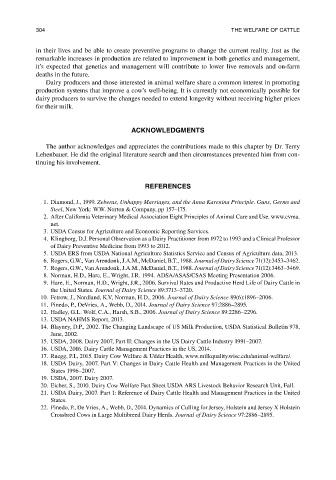Page 327 - The Welfare of Cattle
P. 327
304 the WeLfare of CattLe
in their lives and be able to create preventive programs to change the current reality. Just as the
remarkable increases in production are related to improvement in both genetics and management,
it’s expected that genetics and management will contribute to lower live removals and on-farm
deaths in the future.
Dairy producers and those interested in animal welfare share a common interest in promoting
production systems that improve a cow’s well-being. It is currently not economically possible for
dairy producers to survive the changes needed to extend longevity without receiving higher prices
for their milk.
aCKNOWLeDGMeNtS
The author acknowledges and appreciates the contributions made to this chapter by Dr. Terry
Lehenbauer. He did the original literature search and then circumstances prevented him from con-
tinuing his involvement.
reFereNCeS
1. Diamond, J., 1999. Zeberas, Unhappy Marriages, and the Anna Karenina Principle. Guns, Germs and
Steel, New York: W.W. Norton & Company, pp 157–175.
2. After California Veterinary Medical Association Eight Principles of Animal Care and Use. www.cvma.
net.
3. USDA Census for Agriculture and Economic Reporting Services.
4. Klingborg, D.J. Personal Observation as a Dairy Practitioner from 1972 to 1993 and a Clinical Professor
of Dairy Preventive Medicine from 1993 to 2012.
5. USDA ERS from USDA National Agriculture Statistics Service and Census of Agriculture data, 2013.
6. Rogers, G.W., Van Arendonk, J.A.M., McDaniel, B.T., 1988. Journal of Dairy Science 71(12):3453–3462.
7. Rogers, G.W., Van Arendonk, J.A.M., McDaniel, B.T., 1988. Journal of Dairy Science 71(12):3463–3469.
8. Norman, H.D., Hare, E., Wright, J.R. 1994. ADSA/ASAS/CSAS Meeting Presentation 2006.
9. Hare, E., Norman, H.D., Wright, J.R., 2006. Survival Rates and Productive Herd Life of Dairy Cattle in
the United States. Journal of Dairy Science 89:3713–3720.
10. Fetrow, J., Nordland, K.V, Norman, H.D., 2006. Journal of Dairy Science 89(6):1896–2006.
11. Pinedo, P., DeVries, A., Webb, D., 2014. Journal of Dairy Science 97:2886–2895.
12. Hadley, G.L. Wolf, C.A., Harsh, S.B., 2006. Journal of Dairy Science 89:2286–2296.
13. USDA NAHMS Report, 2013.
14. Blayney, D.P., 2002. The Changing Landscape of US Milk Production, USDA Statistical Bulletin 978,
June, 2002.
15. USDA, 2008. Dairy 2007, Part II: Changes in the US Dairy Cattle Industry 1991–2007.
16. USDA, 2016. Dairy Cattle Management Practices in the US, 2014.
17. Ruegg, P.I., 2015. Dairy Cow Welfare & Udder Health, www.milkquality.wisc.edu/animal-welfare/.
18. USDA Dairy, 2007. Part V: Changes in Dairy Cattle Health and Management Practices in the United
States 1996–2007.
19. USDA, 2007. Dairy 2007.
20. Eicher, S., 2010. Dairy Cow Welfare Fact Sheet USDA ARS Livestock Behavior Research Unit, Fall.
21. USDA Dairy, 2007. Part 1: Reference of Dairy Cattle Health and Management Practices in the United
States.
22. Pinedo, P., De Vries, A., Webb, D., 2014. Dynamics of Culling for Jersey, Holstein and Jersey X Holstein
Crossbred Cows in Large Multibreed Dairy Herds. Journal of Dairy Science 97:2886–2895.

